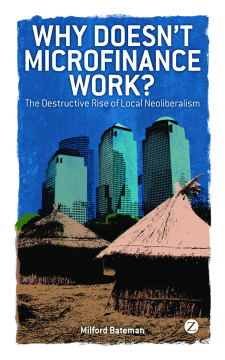
Additional Information
Book Details
Abstract
Since its emergence in the 1970s, microfinance has risen to become one of the most high-profile policies to address poverty in developing and transition countries. It is beloved of rock stars, movie stars, royalty, high-profile politicians and ‘troubleshooting’ economists.
In this provocative and controversial analysis, Milford Bateman reveals that microfinance doesn’t actually work. In fact, the case for it has been largely built on hype, on egregious half-truths and – latterly – on the Wall Street-style greed of those promoting and working in microfinance. Using a multitude of case studies, from India to Cambodia, Bolivia to Uganda, Serbia to Mexico, Bateman demonstrates that microfi nance actually constitutes a major barrier to sustainable economic and social development, and thus also to sustainable poverty reduction. As developing and transition countries attempt to repair the devastation wrought by the global financial crisis, Why Doesn’t Microfinance Work? argues forcefully that the role of microfinance in development policy urgently needs to be reconsidered.
'It's a timely, much-needed, and must-read book for anyone interested in the problems of development assistance.'
David Ellerman, author of Helping People Help Themselves
'Microfinance has suffered too long from unthinking enthusiasm, but some negative views are beginning to make themselves heard. Bateman is the first, however, to examine microfinance critically and coherently as a whole, and to take a sceptical long term view of its social and economic effects.'
Malcolm Harper, Cranfield School of Management
'DO NOT READ THIS BOOK - if you wish to retain the myths attached to microfinance rather than enjoy and appreciate the best available scholarly, reasoned and readable critique.'
Ben Fine, SOAS
Milford Bateman is a freelance consultant specialising in local economic development policy, particularly in relation to the Western Balkans. He has worked as a consultant for most of the major international development agencies and for several of the major international NGOs. He is also currently a Visiting Professor of Economics at the University of Juraj Dobrila at Pula, Croatia.
Table of Contents
| Section Title | Page | Action | Price |
|---|---|---|---|
| About the author | i | ||
| Preface | vi | ||
| Acronyms | x | ||
| 1 | Introduction | 1 | ||
| Bringing reality back in | 4 | ||
| 2 | The rise of microfinance | 6 | ||
| Birth of an idea | 7 | ||
| The case for microfinance | 24 | ||
| Conclusion | 26 | ||
| 3 | Microfinance myths and realities | 28 | ||
| The basic myths behind the microfinance model | 29 | ||
| Myths behind the ‘new wave’ microfinance model | 49 | ||
| Conclusion | 59 | ||
| 4 | Microfinance as poverty trap | 60 | ||
| What do microfinance impact assessments tell us? | 61 | ||
| Figure 4.1 Simple response to an increase in supply of microenterprises | 65 | ||
| Microfinance and key development triggers | 78 | ||
| Conclusion | 110 | ||
| 5 | Commercialization: the death of microfinance | 112 | ||
| Background to commercialization | 113 | ||
| The gathering storm | 118 | ||
| Table 5.1 The rise of consumer microloans in selected countries | 137 | ||
| The perfect storm – the ‘Compartamos affair’ | 142 | ||
| Key problematic issues raised by the Compartamos episode | 146 | ||
| Conclusion | 152 | ||
| 6 | The politics of microfinance | 154 | ||
| Bringing capitalism to the poor to make capitalism safe for the rich | 156 | ||
| Microfinance is local neoliberalism | 160 | ||
| Conclusion | 164 | ||
| 7 | Alternatives to conventional microfinance | 166 | ||
| A preliminary word on at-risk groups | 167 | ||
| Financial sector models associated with local and regional development success | 169 | ||
| Vietnam – a special case of ‘progress with the wrong model’ | 191 | ||
| Conclusion | 198 | ||
| 8 | Conclusion: the need for a new beginning | 201 | ||
| Concluding thoughts | 210 | ||
| Notes | 213 | ||
| to 1 and 2\r | 213 | ||
| to 3 | 216 | ||
| to 4 | 218 | ||
| to 5 | 225 | ||
| to 6 | 229 | ||
| to 7 | 230 | ||
| to 8 | 232 | ||
| Bibliography | 233 | ||
| Index | 253 |
